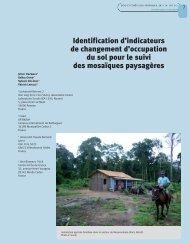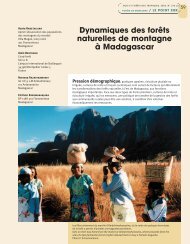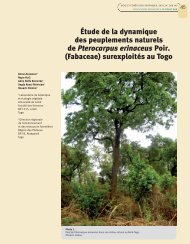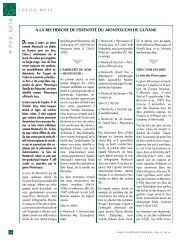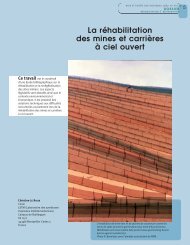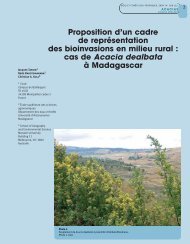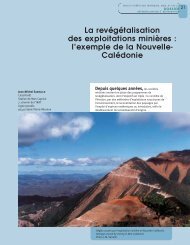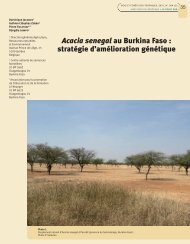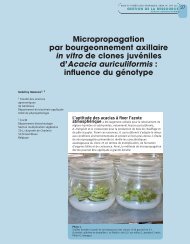les îlots forestiers de la plaine côtière to golaise - Bois et forêts des ...
les îlots forestiers de la plaine côtière to golaise - Bois et forêts des ...
les îlots forestiers de la plaine côtière to golaise - Bois et forêts des ...
You also want an ePaper? Increase the reach of your titles
YUMPU automatically turns print PDFs into web optimized ePapers that Google loves.
SMALL FORESTED AREAS<br />
S Y N O P S I S<br />
SMALL FORESTED AREAS IN THE COASTAL LOWLANDS OF TOGO<br />
The moist tropical forests of West Africa extend<br />
along the entire coast. On the Gulf of<br />
Guinea the swathe is broken by the<br />
Dahomey corridor. This open <strong>la</strong>ndscape inclu<strong>de</strong>s<br />
re<strong>la</strong>tively small forested areas. This<br />
article <strong>de</strong>scribes the main p<strong>la</strong>nt groups in<br />
these forested areas in Togo’s coastal low<strong>la</strong>nds.<br />
The conditions in which each group<br />
grows are <strong>de</strong>fined and compared <strong>to</strong> those<br />
of regional forests close by. This study thus<br />
helps <strong>to</strong> <strong>de</strong>velop the discussion about the<br />
existence of this corridor in the heart of the<br />
forests of West Africa.<br />
PREPARING THE STUDY<br />
Pho<strong>to</strong>-interpr<strong>et</strong>ation was used <strong>to</strong> i<strong>de</strong>ntify<br />
296 small forested areas covering some<br />
2 0 0 0 0 ha. Fifty-three of these areas (18%),<br />
drawn by lot, were selected for study. They<br />
cover 7 7 6 7 ha, which gives an average<br />
size per area of 146.5 + or – 7 4 . 5 h a .<br />
Floristic samp<strong>les</strong> (344) were taken in 500 m 2<br />
plots, which represents a 0.2% sampling<br />
rate. All the species were recor<strong>de</strong>d on a present/absent<br />
basis. By processing the sample<br />
data, it has been possible <strong>to</strong> draw up a representative<br />
floristic listing of the forested<br />
areas. Phy<strong>to</strong>-geographical c<strong>la</strong>ssification and<br />
biological form are specified for each<br />
species. The main analyses carried out on<br />
the samp<strong>les</strong> are of three types:<br />
– fac<strong>to</strong>r analysis of associations [FAA] <strong>to</strong><br />
specify the overall ecological s<strong>et</strong>ting of the<br />
study;<br />
– in<strong>de</strong>xed ecological <strong>de</strong>scriptions helping<br />
<strong>to</strong> form ecological groups-species s<strong>et</strong>s with<br />
a simi<strong>la</strong>r distribution with regard <strong>to</strong> an ecological<br />
fac<strong>to</strong>r;<br />
– calcu<strong>la</strong>tion of links b<strong>et</strong>ween species <strong>to</strong><br />
<strong>de</strong>fine p<strong>la</strong>nt groups.<br />
FINDINGS<br />
KOUAMI KOKOU, GUY CABALLÉ<br />
Inven<strong>to</strong>ries have listed 649 species in the<br />
small forested areas, 1.7% of which are<br />
megaphanerophytes (> 30 m in height).<br />
Mesophanerophytes with a height of b<strong>et</strong>ween<br />
8 and 30 m account for 9.8%, microphanerophytes,<br />
b<strong>et</strong>ween 0.25 and 2 m<br />
in height represent 26%, and other forms<br />
(chamephytes, hemicryp<strong>to</strong>phtes, geophytes,<br />
therophytes and epiphytes) 19.2%.<br />
Eleven p<strong>la</strong>nt groups were <strong>de</strong>scribed in the<br />
forested areas in three ecological sec<strong>to</strong>rs<br />
<strong>de</strong>fined by fac<strong>to</strong>r analysis of associations<br />
[FAA].<br />
ON COASTAL SAND AND ALLUVIAL<br />
DEPOSITS<br />
– Dryp<strong>et</strong>es floribunda p<strong>la</strong>nt community on<br />
old coastal dunes;<br />
– Forest Diospyros abyssinica p<strong>la</strong>nt community<br />
on sand strips created by rivers and<br />
streams;<br />
– Azadirachta indica p<strong>la</strong>nt community on<br />
relict edges and in relict thick<strong>et</strong>s of the<br />
above communities.<br />
ON THE PLATFORM (PRECAMBRIAN<br />
SHELF) AND BAR<br />
– Griffonia simplicifolia p<strong>la</strong>nt community<br />
with many species in common with p<strong>la</strong>tform<br />
communities;<br />
– Micro<strong>de</strong>smis puberu<strong>la</strong> p<strong>la</strong>nt community,<br />
the main p<strong>la</strong>tform community;<br />
– Momordica charantia p<strong>la</strong>nt community,<br />
typical of the edges of the main p<strong>la</strong>tform<br />
community;<br />
– Co<strong>la</strong> gigantea p<strong>la</strong>nt community on hydromorphic<br />
soil in <strong>de</strong>pressions, fire-prone;<br />
– Hymenostegia afzelii p<strong>la</strong>nt community<br />
associated with tributaries of the river<br />
Mono.<br />
IN THE VALLEYS<br />
– Cleis<strong>to</strong>pholis patens p<strong>la</strong>nt community <strong>de</strong>fined<br />
in the galleries close <strong>to</strong> the southern<br />
part of the Togo Mountains;<br />
– Pterocarpus santalinoi<strong>de</strong>s p<strong>la</strong>nt community<br />
typical of the lower Zio valley;<br />
– Diospyros mespiliformis p<strong>la</strong>nt community<br />
in the Haho and Mono valleys.<br />
DISCUSSION<br />
The veg<strong>et</strong>ation spectrums in the small forested<br />
areas in southern Togo are very simi<strong>la</strong>r<br />
<strong>to</strong> those of Benin: 1.7% in Togo as compared<br />
with 1.2% in Benin for<br />
megaphanerophytes, 9.8% in Togo as compared<br />
with 8.8% in Benin for mesophanerophytes,<br />
43.3% in Togo as compared<br />
with 41.3% in Benin for<br />
microphanerophytes. This means that the<br />
small forested areas in southern Togo show<br />
features that are shared with Benin.<br />
More than 80% of species have a forest<br />
affinity. So although forested areas in<br />
southern Togo and Benin may be drier<br />
than the forests in the east and west of<br />
these two countries, the Dahomey corridor<br />
has very little influence on forest species<br />
d i s t r i b u t i o n .<br />
The p<strong>la</strong>nt groups taken as a whole can be<br />
divi<strong>de</strong>d in<strong>to</strong> two forest types: (1) coastal forest<br />
<strong>de</strong>veloping in coastal sand and alluvial<br />
<strong>de</strong>posits; (2) dry semi-<strong>de</strong>ciduous forest on<br />
the p<strong>la</strong>tform and the bar and in the valleys.<br />
It is very wi<strong>de</strong>spread in West Africa, from<br />
Senegal <strong>to</strong> Nigeria.<br />
In comparison with phy<strong>to</strong>-ecological and<br />
phy<strong>to</strong>-sociological operations in West<br />
Africa, several groups i<strong>de</strong>ntified in the small<br />
forested areas occur in other forests in<br />
Benin, Ghana and Côte d’Ivoire. But they<br />
are all different from the forest types <strong>de</strong>scribed<br />
in the moist tropical forests of West<br />
Africa.<br />
The size of some of these small forested<br />
areas (4 000 ha) means that they may be<br />
the outcome of the <strong>la</strong>rger Guinean forest receding,<br />
or of certain sites favourable <strong>to</strong> this<br />
forest type, which have been occupied for a<br />
long time, with no prospect of expansion<br />
due <strong>to</strong> human pressure. As far as the smal<strong>les</strong>t<br />
forested areas are concerned, the traditional<br />
beliefs of local Togo<strong>les</strong>e people show<br />
that most of them have probably been created.<br />
This is so with most of the sacred<br />
forests and “firebreak” forests growing<br />
around vil<strong>la</strong>ges.<br />
BOIS ET FORÊTS DES TROPIQUES, 2000, N° 263 (1)<br />
51





